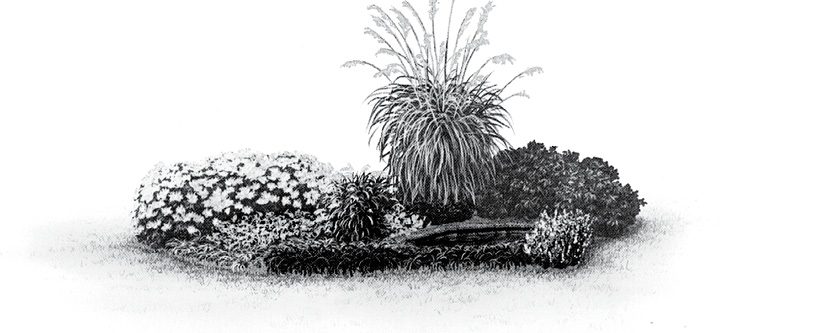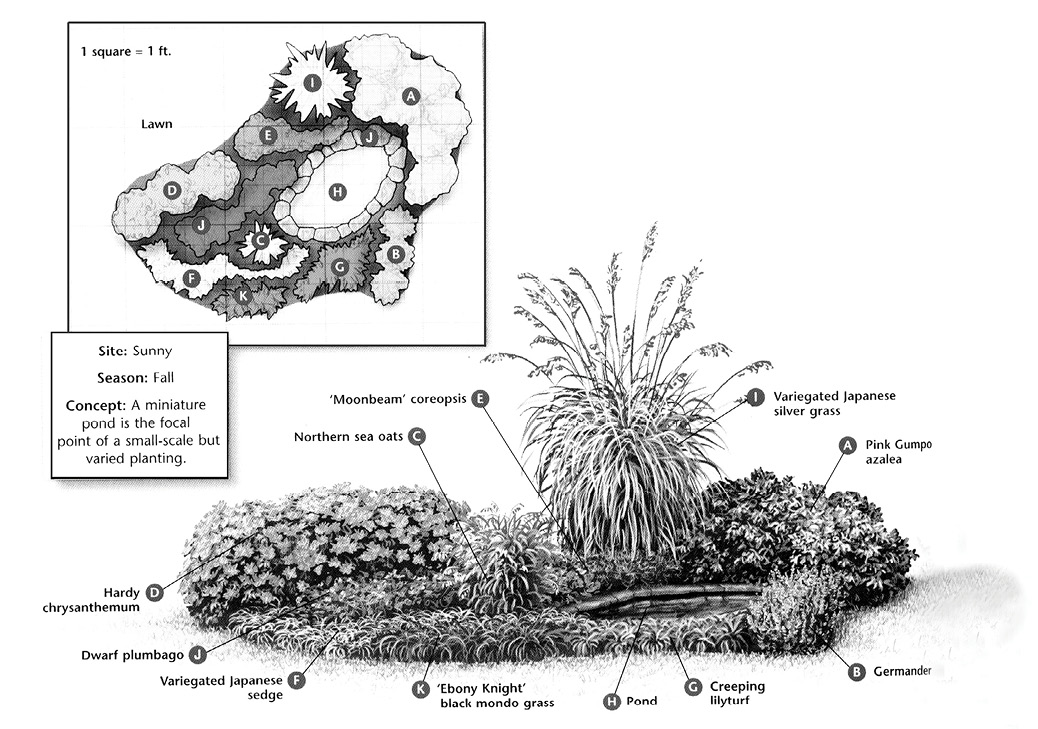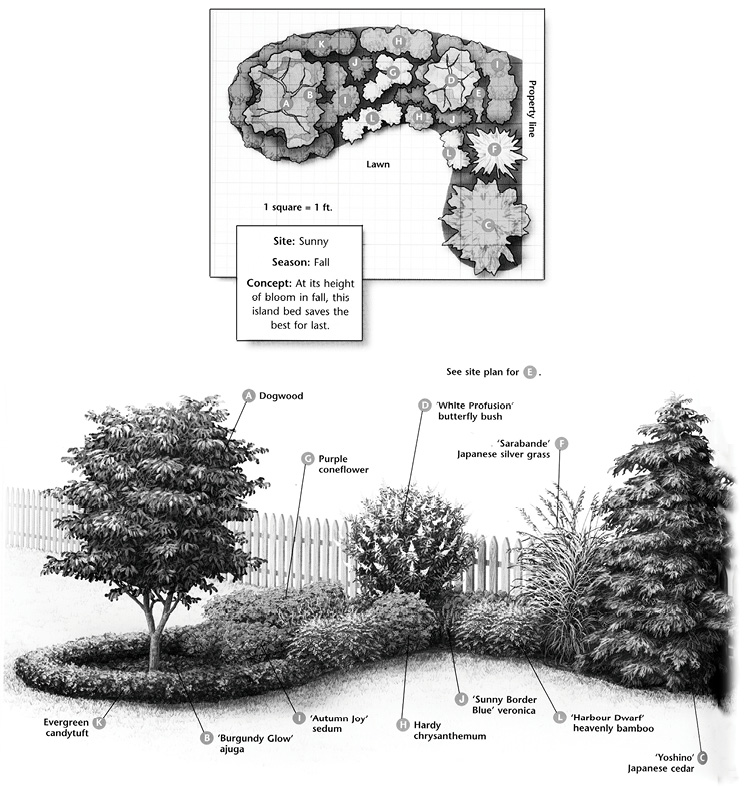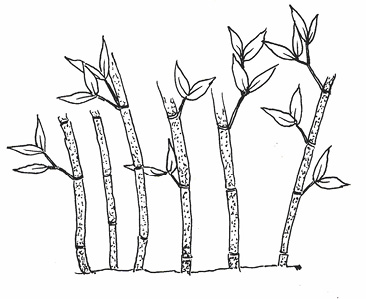Ornamental Grasses for the Midsouth Landscape

Ornamental grasses with their variety of form, color, texture, and size add diversity and dimension to a landscape. Not many other groups of plants can boast attractiveness during practically all seasons. The only time they could be considered not to contribute to the beauty of the landscape is the few weeks in the early spring between cutting back the old growth of the warm-season grasses until the sprouting of new growth. From their emergence in the spring through winter, warm-season ornamental grasses add drama, grace, and motion to the landscape unlike any other plants.
One of the unique and desirable contributions ornamental grasses make to the landscape is their sound. Anyone who has ever been in a pine forest on a windy day is aware of the ethereal music of wind against pine foliage. The effect varies with the strength of the wind and the season, from the rustling of a slight summer breeze to the sharp, crisp sound of brisk winter winds bending the dry seedheads and foliage. Light adds to the musical display. Some grasses come into their glory when backlit by the setting sun. You can lengthen this display into the night by adding outdoor lighting.
Planting grasses near water, where light, sound, and wind is reflected and amplified, is another way to maximize the dramatic impact in the landscape. For an example of a design plan for a small water garden, see Figure 1.

True grasses make up a large group of monocots (Liliopsida) within the Gramineae or Poaceae family. There are approximately 10,000 species of grasses. Although they may seem similar, grasses vary greatly, ranging from cool season to warm season grasses, from woody to herbaceous, and from annuals to long-lived perennials.
This variation has resulted in five recognized subfamilies within Poaceae. They are Arundinoideae, a unique mix of woody and herbaceous grass species; Bambusoideae, the bamboos; Chloridoideae, warm-season herbaceous grasses; Panicoideae, also warm-season herbaceous grasses; and Pooideae, a cool-season subfamily.
Their habitats also vary. Grasses are found across the globe, including in Antarctica. They have a strong presence in prairies, like those in the Great Plains, and savannas, like those in southern Africa. It is important to recognize these natural characteristics when using grasses for ornament, since they determine adaptability and management within a landscape or region, as well as invasive potential.
Several grasses are cultivated for forage, turf, ornamental, and wildlife benefits. Although the focus of this publication is ornamental grasses, these grasses may serve wildlife in the landscape as well. In addition, native ornamental grasses may add natural heritage value to a landscape.
Grasses can be broadly grouped as herbaceous or woody. Even though grass-like ornamentals, such as Liriope spp., Lomandra spp., Ophiopogon spp., and close grass relatives, such as the sedges (Cyperaceae) and rushes (Junaceae) can be included in the general category of “ornamental grasses,” they are not true grasses and are not discussed in this publication.
Using Ornamental Grasses in Landscape Design
Beauty is reason enough to use grasses in the landscape, but grasses can also be useful. If a landscape has a special need, an ornamental grass probably can fill that need. Whether you need a ground cover, a screen, a specimen plant, or a container plant, you have many choices of grasses to fill those needs. The comments section of the tables at the end of this publication gives specific landscape features for each grass.
Grasses can attract wildlife by providing food, nesting, and cover. Grasses in combination with other perennials or annuals can add to the layers of vegetation that attract wildlife by providing a transition or bridge between the woods and the lawn’s edge. The larger grasses can function as outdoor room dividers, directing and controlling traffic or movement through the garden. Larger grasses can act as subtle backdrops for showier other plants, and even as windbreaks. Smaller grasses can be ground covers, container plants, edging, and erosion control. Both large and small can fill multiple duties, such as specimen, erosion control, foundation plant, and wildlife habitat. See Figure 2 for an example of an attractive corner planting that incorporates ornamental grass.

Design and Selection Tips for Ornamental Grasses
Combining different grasses, or grasses with shrubs, flowers, or other ornamentals, can be both daunting and fun—there are so many choices! The only limiting factor could be local availability. Thankfully, as grasses have become more popular, availability has increased. More and more garden centers and nurseries have a wide selection. If you cannot find a particular grass at a local garden center or nursery, search online for mail order nurseries. You can find many other sources using Internet search engines.
When combining grasses with other ornamentals, consider using plants with bold, coarse textured foliage to offset the feathery, mounding form and soft texture of certain other grasses. For example, combine muhly grass (Muhlenbergia) with the large, boldly-colored foliage of Tropicana, or Bengal Tiger cannas, Lime Ginger or Black Magic elephant ears, or any banana plant around a pool or water garden. Add a few narrow-leaf evergreen shrubs for winter interest to contrast with the neutral color of the dormant grass, and you have a planting that is attractive through all seasons with little leaf litter to get into the water.
Ornamental grasses adapt themselves well to many situations, sliding easily into beds and borders with many other annuals or perennials. Grasses with their muted colors and graceful shapes can serve as the anchor to “set off” their neighbors. Using grasses with sedums such as Autumn Joy and the orange coneflower Rudbeckia fulgida Ait. is a classic combination. Purple coneflower, coreopsis, daylilies, and a host of other perennials combine well with grasses.
When selecting a grass, consider the mature size and shape. Many grasses can overpower their weaker, less robust companions. Proper accommodation of their size when selecting the site prevents the cost of renting a backhoe to remove the overgrown giant later. Be aware of the fall color, if any, and the flowering season and color to know if the grass will complement neighboring plants. Consider ease of maintenance when making a selection.
Also, know how the plant reproduces before making a selection. Is the plant an aggressive invader, spreading by rhizome or root? If so, select a site you can confine, such as a container or bed with a physical barrier of some sort. Does it self-sow readily from seed? If so, there are a few management choices—either remove the flowers before seed are formed (which would probably be a shame if the flowers were attractive), or be ready to be a vigilant weeder. A third option is to apply a pre-emerge herbicide at the right time to prevent the seed from developing into seedlings.
Using Grasses in Specialty or Theme Gardens
Because grasses are so diverse and adaptable, they can be used in many types of gardens. Ranging from the large estate owner who employs a bevy of gardening staff to the apartment or dorm dweller whose garden consists of one lone container, anyone can grow and enjoy ornamental grass.
Grasses have a place in many theme gardens. For example, ornamental grasses, such as the bamboos, are used extensively in Japanese gardens. Other theme gardens in which grasses could play a role could be a Biblical garden, since the giant reed (Arundo donax L.) is believed by many to be the bulrush of the Bible. This garden could include a sorghum plant as well, because some Biblical botanists believe this to be the reed in the crucifixion verses. An herb garden would include the lemon grass [Cymbopogon citratus (DC.) Stapf].
Container Gardens
Container gardens can be large or small, combinations of plants, or just one specimen. Pick the container to match the needs of the plant(s) and to complement the surroundings. Combine several sizes, shapes, and colors of pots into a nice grouping, or pair identical pots on either side of an entryway. Remember that container gardens typically need more attention than the same plants in the ground. Be especially mindful of watering. Use grasses in containers the same way they are used in the landscape, for example, as an accent or focal point of the planting or as a background for the more colorful plants. Grasses can be the large, vertical element of the container or the low, spreading, or cascading element of the container garden. The more aggressive spreaders such as the bamboos could be easily restricted in a container.
Rock or Trough Gardens
Because many types of grasses are very drought tolerant once established and some are dwarf as well, they can be included in rock or trough gardens. You can have fun experimenting to find the best selections.
Water Gardens
Besides the beauty they contribute, grasses can stabilize the edge of a lake, small pond, or stream to prevent erosion. Examples are bamboo or giant reed. Grasses contribute little plant litter to the water, unlike many other ornamental plants. You can choose from many selections that can grow in or near water.
Wildlife Gardens
If you are interested in developing a landscape that is attractive to wildlife, certainly include grasses. Birds and other wildlife feed on the seed heads of many grasses. Many types of wildlife, including birds and small mammals, use the foliage for cover and nesting. Having a diversity of grasses combined with flowering trees, shrubs, and other flowering plants attracts a diversity of wildlife that can add to the sustainability of your landscape.
Craft or Cutting Garden
Floral designers or craftsmen can find many uses for ornamental grasses in their art. The fluffy, colorful flowers and the arching or mounding foliage lend themselves to fresh or dried arrangements. Creating interior accents such as wreaths, garlands, topiaries, swags, or other arrangements with grass inflorescences or foliage is easy and fun for the do-it-yourselfer as well as the professional designer. In particular, incorporating grasses into autumn décor is popular and attractive. A table centerpiece of small, colorful ornamental gourds arranged with a vase of fall flowers and grasses can be very festive. Adorning the front door with a wreath woven from fall foliage, vines, and branches and decorated with seedpods, cones, and ornamental grasses creates a colorful welcome for any visitors.
Native Garden
Interest is increasing in restoring landscapes to a more native version of the original landscape of this country before the influence of Europeans. Some reasons for using natives include the idea that natives are easy to maintain, they are hardy and adaptable, they are historically interesting, or you might have an interest in plant heritage. Native grasses certainly were a big part of the native flora of the Midsouth and should be an integral part of any native garden. Native grasses are designated as such in the tables in the back of this publication.
For those interested in preserving the local ecotypes, seed or plants collected from locally grown stock can be preferable to those seed or plants grown in another geographic area. Plants with a wide range may exhibit naturally occurring variations, each more suited to one particular region. For example, it just makes sense that a native grass such as little bluestem that is grown from stock in Maine may not be as well suited to your area of the Midsouth as the same little bluestem that is from stock grown in Carriere, Mississippi.
Meadow or Prairie Garden
For those interested in establishing or preserving an area of the landscape as a meadow or prairie, grasses would certainly be a part of the process. Purists might want to stick with using the natives, but introduced grasses can be nice, well behaved additions to a home meadow or prairie area. As two Mississippi native plant enthusiasts, Gail Barton and Marc Pastorek have said, “grasses are the canvases on which wildflowers should be painted.” For further information on establishing a wildflower meadow, see Extension Publication 1709 Wildflowers for Mississippi Meadows and Gardens.
Herbaceous Grasses
Many herbaceous grasses are used as ornamentals. These include many native and introduced ornamental grass species. Grass genera such as Andropogon, Miscanthus, Panicum, and Uniola fit within this group. These grasses may be annual or perennial, cool- or warm-season. As you can see, use and management in the landscape can be quite variable. Some can be established from seed, while others are only vegetatively planted, especially variegated grasses.
Some literature is available on ornamental grasses, but this information is not generally specific to the Midsouth region, including Alabama, Arkansas, Louisiana, Mississippi, and Tennessee. A list of herbaceous grasses considered adapted to the Midsouth is provided in a table at the end of this publication.
Woody Grasses
Woody Grasses include the bamboos (subfamily: Bambusoideae), such as black, goldengroove, and golden bamboos (Phyllostachys spp.), and a few other upright perennial grasses (subfamily: Arundinoideae), such as giant reed (Arundo donax), reed [Phragmites australis (Cav.) Trin. ex Steud.], and others. Although these grasses are often tall, some are short and used as groundcovers.
Many bamboos are now commercially available. Information on many considered adapted to the Midsouth is provided at the end of this publication.
Bamboos include spreaders and clumpers. See Figures 3 and 4 for growth habits. With clumping bamboo, stalks orginate from one area and fan out as they grow upward. The stalks of spreading bamboo are spread out across the ground. Although spreaders can fill voids for screening, they can also be invasive and very difficult to kill once established. Always consider the long-term effects of planting such grasses. For this reason, you may prefer clumpers, such as Bambusa multiplex (Lour.) Raeusch. ex Schult. & Schult. f. and others.


Invasive or Weedy Ornamental Grasses
Aside from their use as ornamentals, some ornamental grasses can pose a serious risk of invasion in the landscape. This is particularly true of introduced ornamental grasses, and some, like giant reed, are now regulated as federal or state noxious weeds. Other introduced ornamental grasses may escape within the landscape and cause problems but are not regulated. These grasses should require special management considerations or be avoided.
New ornamental grasses are continually introduced. Be cautious, and avoid purchasing and/or planting problematic or invasive grasses. Planting invasive grasses can result be costly and require hard work to remove from the landscape and possibly surrounding landscapes.
Because of problems from certain introduced grasses, many landscapes now host native grasses. Although some native grasses can be invasive, they are a part of the natural heritage of this country and of lesser concern. Some native alternatives to exotic invasive ornamental grasses are provided in the back of this publication. It is important to remember that an invasive grass in one state or region may not be invasive in another state or region. Like other invasive species, invasive grasses can have regional specificity. When in doubt, it is better to be cautious or avoid using such grasses.
Propagation of Ornamental Grasses
It is important to understand the differences between cool-season and warm-season grasses when propagating. Cool-season grasses, also called C3 grasses, prefer cooler growing temperatures in the fall and spring. These grasses are best propagated in fall before more favorable growing conditions. Warm-season grasses, also called C4 grasses, prefer warmer growing conditions in summer. These grasses are best propagated in spring before more favorable conditions. Most Southern ornamental grasses are warm-season grasses.
Propagation can be vegetative or by seed. Many cultivars should only be propagated vegetatively, including variegated cultivars or those with distinctive leaf or other specific characteristics. This is the most common way to propagate ornamental grasses. But for large areas of native grasses, this method may be too expensive.
Seed propagation is generally desirable under these circumstances, although species and cultivar options can be limited. You can collect seed locally, but in most cases large commercial growers ship seed to local retailers across the country. This seed may not contain local ecotypes of native grasses, but the cultivars may be well adapted to this region. Whether adapted or not, it is important to remember that management options, such as fertilization, landscape placement, and irrigation, can overcome many issues with poor adaptation. Grasses requiring management to survive in the landscape are usually less invasive.
Naturalizing with Native Grasses
Naturalizing usually pertains to larger areas where a natural, less formal landscape is desired. Establishment and management of these areas are similar to that used on golf courses, pastures, and natural areas. Research has been conducted on seed establishment and management of native grass stands, and information available on establishing and managing native grasses is also available on the web.
Generally large areas of native grasses are established by seed. Warm-season grasses are generally seeded in the spring, while cool-season grasses are seeded in the fall. The typical planting unit is pounds (lbs) Pure Live Seed (PLS) per acre. Planting mixes of more than one species is common. Seed can be broadcast by hand or rotary spreader. But seed with a lot of hair will not broadcast from a rotary spreader. Hand broadcasting, with the addition of sand, is generally necessary. Such seed can be hydroseeded or hydromulched, but this requires specialized equipment.
Typical seeding rates for common, warm-season grasses are 20 lbs PLS/A for big bluestem (Andropogon gerardii Vitm.), 5 lbs PLS/A for broomsedge (Andropogon virginicus L.), 30 lbs PLS/A for indiangrass [Sorghastrum nutans (L.) Nash], 25 lbs PLS/A for little bluestem [Schizachyrium scoparium (Michx.) Nash], and 10 lbs PLS/A for switchgrass (Panicum virgatum L.). Perennial grasses can be slow to establish and may take two or more years to reach maturity. Switchgrass tends to reach maturity faster than other native perennial grasses and is one of the few you can broadcast with a rotary spreader.
Weeds are often an issue in establishing seeded cultivars. Weed seed may be a result of disturbance of the existing soil-seed bank and/or a result of contamination in the purchased seed. Either way, weeds can cause establishment failure if not dealt with in a timely manner.
You can mow taller weeds while grasses are short. Some weeds can be hand pulled, but larger stands may require herbicides. Certain broadleaf herbicides for broadleaf weed control are usually safe on most native grasses. However, very small, newly emerged grass seedlings may be injured by herbicides that are safe to well-established grasses. Test low rates of herbicides on small areas of newly emerged grasses to check species tolerance before treating large areas. Herbicides containing 2,4-D or similar products are typical, but always read and follow label directions, and consider seedling maturity.
Other Seeded Grasses
A few other ornamental grasses are seed propagated. These include a few cool-season annuals and perennials, such as Festuca, and a small number of warm-season annual and perennial grasses, such as Coix and certain Pennisetum spp. These are best planted in small containers until established and then transplanted into the landscape.
Vegetative Propagation of Herbaceous Ornamental Grasses
Vegetative propagation is the most common form of propagation for herbaceous perennial ornamental grasses. It is almost always done by division of rhizomes, stolons, or tillers of larger plants. This is best practiced early in or just before the growing season to allow time for full development. This would be fall for cool-season grasses and early spring for warm-season grasses. You can grow recently divided plants in containers to encourage quicker establishment.
Vegetative Propagation of Bamboos
Bamboos are propagated from rhizomes, since plants may take years to flower. Clumping bamboos, such as Bambusa multiplex, have very short rhizomes and can be more difficult to propagate. Spreading bamboos, such as Phyllostachys, are easier to propagate, although most bamboos are slow to establish. It is important to have several nodes on each rhizome being propagated. Avoid excessive bending when planting.
Once planted, the bamboo may not have full vigor for a year or more. First culms (stalks or shoots) are generally smaller, eventually reaching full size over time.
Once established, bamboos can live for many years. You may see them at old home sites long after homeowners have left. Thus, keep this in mind when planting spreading bamboos, since they may spread to adjacent property and cause poor relations with neighbors.
Larger bamboos may need a a culm-and-a-half or more width of mowed space to keep plants from crossing an area. For example, if the mature height is expected to be 30 feet, then allow 45 feet or more of lawn space around the planting area.
Smaller bamboos, such as Pleioblastus pygmaeus (Miq.) Nak., can tolerate certain amounts of mowing and may spread easily into areas where they are not wanted. Thus, enclose small, groundcover-type bamboos to prevent unwanted spread. Use concrete or steel ground barriers. Always make sure they are much deeper than the rhizomes.
Management of Ornamental Grasses
Grasses typically respond well to fertilization. But over fertilizing can cause lodging, which is not desirable. Once established, many ornamental grasses do not need fertilization, so this is one of the benefits of using ornamental grasses. Rates of 1 lb of nitrogen per 1000 sq. ft. per growing month should be adequate for establishing most ornamental grasses.
Remember that growing seasons are different for cool- and warm-season grasses. The first application during the growing season could include an even analysis fertilizer (e.g. 13-13-13). We recommend a soil test analysis before you apply complete fertilizers.
Pruning is often necessary for grasses, since determinate flowering is typical. Determinate flowering means that once flowering is complete, the flowering culm eventually dies. Culms may be annual or take a year or more to flower, so you may not want to remove all foliage.
You can remove individually flowering culms from some grasses, such as pampas grass [Cortaderia selloana (Schult.& Schult.F.) Asch.& Grabn.], while others may be cut back to around 6 inches above the soil surface before each growing season. This would be early spring for warm-season grasses or late summer to early fall for cool-season grasses. Although this is not required, removing dead material can add to the looks of the grass. It is best to remove only dead material from bamboos, since bamboo culms are perennial. Perennial ornamental grasses generally do not require much tillage once established. You can mulch and maintain these grasses similar to other perennial ornamentals.
Weed Management in Ornamental Grasses
Ornamental grasses may be damaged by post-emergent graminicides, such as Fusilade (fluazifop-p-butyl) and Poast (sethoxydim). Don’t use these on ornamental grasses unless the label specifically says so. Certain broadleaf and pre-emergent herbicides may be safe on ornamental grasses, but always check herbicide labels before use.
|
Scientific Name1 |
Common Name2 |
Comments3 |
Origin of Species4 |
Hardiness5 |
Live Cycle |
Physiology6 |
Sun |
|---|---|---|---|---|---|---|---|
|
Andropogon gerardii Vitm. |
Big Bluestem |
Upright |
Native |
Region |
Perennial |
Warm |
Full |
|
Andropogon gyrans Ashe |
Elliott’s Bluestem |
Upright, silky inflorescence |
Native |
Region |
Perennial |
Warm |
Full |
|
Andropogon ternarius |
Split Beard Bluestem |
Upright, silky tufted inflorescence |
Native |
Region |
Perennial |
Warm |
Full |
|
Bouteloua gracilis (HBK) Griffiths |
Blue Grama |
Fine, grayish foliage; arid species |
SW Native |
Region |
Perennial |
Warm |
Full |
|
Calamagrostis x acutiflora (Schrad.) DC. CV. |
Feather Reedgrass |
Karl Foerster and other cultivars; cool locations |
Hybrid |
Region |
Perennial |
Cool |
Full–Part Shade |
|
Calamagrostis arundinacea (L.) Roth |
Reedgrass |
Clumping; cool locations |
Eur. to Asia Minor |
Region |
Perennial |
Cool |
Full–Part Shade |
|
Calamagrostis brachytricha Steud. |
Korean Feather Reedgrass |
Clumping; cool locations |
C. to E. Asia |
Region |
Perennial |
Cool |
Full–Part Shade |
|
Chasmanthium latifolium (Michx.) Yates |
North American Wild Oats |
Bamboo-like foliage; pendant spikelets |
Native; Eastern U.S. |
Region |
Perennial |
Cool |
Full–Part Shade |
|
Coix lacryma-jobi L. |
Job’s Tears |
Novelty; fruit used for beads |
SE Asia |
Zone 9 |
Annual |
Warm |
Full |
|
Cortaderia selloana (Schult.& Schult.F.) Asch.& Grabn. |
Pampas Grass |
Escaped in SW. White and pink flower forms |
South America |
Region |
Perennial |
Warm |
Full |
|
Cortaderia selloana ‘Gold Band’ |
Gold Band Pampas Grass |
Gold-margined form |
Cultivar |
Zone 8 |
Perennial |
Warm |
Full |
|
Cortaderia selloana ‘Pumila’ |
Dwarf Pampas Grass |
Dwarf form |
Cultivar |
Zone 8 |
Perennial |
Warm |
Full |
|
Cortaderia selloana ‘Silver Stripe’ |
Silver Stripe Pampas Grass |
White variegated form |
Cultivar |
Zone 8 |
Perennial |
Warm |
Full |
|
Cymbopogon citratus (DC. Ex Nees) Stapf |
Lemon Grass |
Lemon scented and grown as herbs |
India, Ceylon |
Zone 9 |
Perennial |
Warm |
Full |
|
Elymus canadensis L. |
Canada Wild Rye |
Gray foliage; bottlebrush inflorescence |
N.A. |
Region |
Perennial |
Cool |
Full–Part Shade |
|
Elymus virginicus L. |
Virginia Wild Rye |
Greenish foliage; bottlebrush inflorescence |
N.A. |
Region |
Perennial |
Cool |
Full–Part Shade |
|
Eragrostis curvula (Schrad.) Nees |
Weeping Lovegrass |
Invasive in W.; fine basal foliage; open inflorescence |
Southern Afr. |
Zone 7 |
Perennial |
Warm |
Full |
|
Eragrostis spectabilis (Pursh) Steud. |
Purple Lovegrass |
Native with reddish inflorescence |
Native; SE U.S. |
Region |
Perennial |
Warm |
Full |
|
Festuca amethystina L. ‘Bronzeglanz’ |
Bronze Glazed Tufted Fescue |
Clumps similar to blue fescue, but more purple |
C. Eur. |
N. Region |
Perennial |
Cool |
Full |
|
Festuca ovina L. var. glauca (Lam.) Hackel |
Blue Fescue |
Clumps of blue-gray foliage; short |
North Temperate |
N. Region |
Perennial |
Cool |
Full |
|
Glyceria maxima (Hartm.) Holmb. |
Reed Mannagrass |
Use variegated varieties for best show |
Temperate Eurasia |
Region |
Perennial |
Cool |
Full |
|
Hakonechloa macra (Munro) Mak. |
Japanese Forest Grass |
Use variegated cultivars, like ‘Aureola’ for best show |
Japan |
Region |
Perennial |
Cool |
Full–Part Shade |
|
Holcus mollis L. |
Creeping Softgrass |
Use variegated varieties for best show |
Eur. |
N. Region |
Perennial |
Cool |
Full–Part Shade |
|
Hordeum jubatum L. |
Squirrel-tail Barley |
Invasive in other regions; bottlebrush inflorescence |
North Temperate |
N. Region |
Annual |
Cool |
Full |
|
Hystrix patula Moench. |
Bottle-brush Grass |
Tufted perennial with bottlebrush inflorescence |
Native; E N.A. |
N. Region |
Perennial |
Cool |
Full–Part Shade |
|
Miscanthus floridulus (Labill.) Warb. |
Maidengrass |
Tall, stems pronounced, rhizomatous (spreading) species |
SE Asia |
Region |
Perennial |
Warm |
Full |
|
Miscanthus oligostachyus Stapf. ‘Purpurescens’ |
Small Maidengrass |
Small; green foliage with reddish fall color |
Japan |
Region |
Perennial |
Warm |
Full |
|
Miscanthus sacchariflorus (Maxim.) Hackel |
Amur Silver Grass |
Tall, rhizomatous (spreading) species |
Asia |
Zone 8 |
Perennial |
Warm |
Full |
|
Miscanthus sacchariflorus ‘Robustus’ |
Large Amur Silver Grass |
Larger, rhizomatous (spreading) species |
Asia |
Zone 8 |
Perennial |
Warm |
Full |
|
Miscanthus sinensis Anderss.* |
Maidengrass, Jap. Silver Grass |
Many cultivars. Avoid using multiple cultivars together |
E. Asia |
Region |
Perennial |
Warm |
Full |
|
Miscanthus sinensis Anderss. ‘Adagio’* |
Adagio Maidengrass |
Dwarf form |
E. Asia |
Zone 7 |
Perennial |
Warm |
Full |
|
Miscanthus sinensis Anderss. ‘Autumn Light’* |
Autumn Light Maidengrass |
Standard form |
E. Asia |
Zone 7 |
Perennial |
Warm |
Full |
|
Miscanthus sinensis Anderss. ‘Cabaret’* |
Cabaret Maidengrass |
Longitudinally white variegated midribs; large plant |
E. Asia |
Zone 7 |
Perennial |
Warm |
Full |
|
Miscanthus sinensis Anderss. var. condensatus* |
Coastal Maidengrass |
Coastal variety |
E. Asia |
Region |
Perennial |
Warm |
Full |
|
Miscanthus sinensis Anderss. ‘Cosmopolitan’* |
Cosmopolitan Maidengrass |
Longitudinally white variegated margins; large plant |
E. Asia |
Zone 7 |
Perennial |
Warm |
Full |
|
Miscanthus sinensis Anderss. ‘Gold Bar’ |
Gold Bar Porcupine Grass |
Dwarf, 36” tall, with horizontal yellow bands, burgundy plumes |
E. Asia |
Zone 5 |
Perennial |
Warm |
Full |
|
Miscanthus sinensis Anderss. ‘Goldfeder’* |
Goldfeder Maidengrass |
Longitudinally gold variegated foliage |
E. Asia |
Region |
Perennial |
Warm |
Full |
|
Miscanthus sinensis Anderss. ‘Gracillimus’* |
Slender Maidengrass |
Compact, narrowleaf form |
E. Asia |
Region |
Perennial |
Warm |
Full |
|
Miscanthus sinensis Anderss. ‘Graziella’* |
Graziella Maidengrass |
Green, large, upright, early flowering |
E. Asia |
Region |
Perennial |
Warm |
Full |
|
Miscanthus sinensis Anderss. ‘Kirk’s Dwarf’* |
Kirk’s Dwarf Maidengrass |
Small plant; transverse cream-gold variegated leaves |
E. Asia |
Region |
Perennial |
Warm |
Full |
|
Miscanthus sinensis Anderss. ‘Morning Light’* |
Morning Light Maidengrass |
Slender, longitudinally white variegated leaves |
E. Asia |
Region |
Perennial |
Warm |
Full |
|
Miscanthus sinensis Anderss. ‘Sarabande’* |
Sarabande Maidengrass |
Slender green leaves |
E. Asia |
Region |
Perennial |
Warm |
Full |
|
Miscanthus sinensis Anderss. ‘Silberfeder’* |
Silver Feather Maidengrass |
Green foliage; silver inflorescence |
E. Asia |
Region |
Perennial |
Warm |
Full |
|
Miscanthus sinensis Anderss. ‘Silberpfeil’* |
Silver Arrow Maidengrass |
Longitudinally white variegated |
E. Asia |
Region |
Perennial |
Warm |
Full |
|
Miscanthus sinensis Anderss. ‘Strictus’* |
Porcupine Maidengrass |
Upright; transversely cream variegated |
E. Asia |
Region |
Perennial |
Warm |
Full |
|
Miscanthus sinensis Anderss. ‘Variegatus’* |
Variegated Maidengrass |
Longitudinally white variegated; standard form |
E. Asia |
Region |
Perennial |
Warm |
Full |
|
Miscanthus sinensis Anderss. ‘Yaku Jima’* |
Yaku Jima Maidengrass |
Dwarf narrowleaf form |
Japan |
Region |
Perennial |
Warm |
Full |
|
Miscanthus sinensis Anderss. ‘Zebrinus’* |
Zebragrass |
Transversely cream variegated; standard form |
E. Asia |
Region |
Perennial |
Warm |
Full |
|
Miscanthus transmorrisonensis Hayata* |
Taiwanese Maidengrass |
Small; evergreen foliage; early flowering |
Taiwan |
Region |
Perennial |
Warm |
Full |
|
Muhlenbergia capillaris (Lam.) Trin. |
Purple Muhly |
Fine basal foliage, red inflorescence |
Native |
Region |
Perennial |
Warm |
Full |
|
Muhlenbergia dumosa Scribn. ex Vasey |
Bamboo Muhly |
Fine foliage on bamboo-like culms |
SW Native |
Zone 8 |
Perennial |
Warm |
Full |
|
Muhlenbergia lindheimeri Hitchc. |
Lindheimer Muhly |
Clumping with fine grayish foliage. |
SW Native |
Zone 7 |
Perennial |
Warm |
Full |
|
Muhlenbergia rigens (Benth.) Hitchc. |
Deergrass |
Fine basal foliage; arid species |
Native; California |
Zone 8 |
Perennial |
Warm |
Full |
|
Panicum virgatum ‘Cloud Nine’ |
Cloud Nine Switchgrass |
Gray leaf form |
Native |
Region |
Perennial |
Warm |
Full |
|
Panicum virgatum L. ‘Hanse Herms’ |
Hanse Herms Switchgrass |
Red leaf form |
Native |
Region |
Perennial |
Warm |
Full |
|
Panicum virgatum ‘Heavy Metal’ |
Heavy Metal Switchgrass |
Gray leaf form |
Native |
Region |
Perennial |
Warm |
Full |
|
Panicum virgatum ‘Northwind’ |
Northwind Switchgrass |
Gray leaf form |
Native |
Region |
Perennial |
Warm |
Full |
|
Panicum virgatum ‘Prairie Sky’ |
Prairie Sky Switchgrass |
Gray leaf form |
Native |
Region |
Perennial |
Warm |
Full |
|
Panicum virgatum ‘Rehbraun’ |
Rehbraun Switchgrass |
Red fall color |
Native |
Region |
Perennial |
Warm |
Full |
|
Panicum virgatum ‘Rotstrahlbusch’ |
Rotstrahlbusch Switchgrass |
Red leaf form |
Native |
Region |
Perennial |
Warm |
Full |
|
Panicum virgatum ‘Shenandoah |
Shenandoah Switchgrass |
Red leaf form |
Native |
Region |
Perennial |
Warm |
Full |
|
Pennisetum alopecuroides (L.) Spreng. * |
Dwarf Fountaingrass |
Clumping; dark bottlebrush inflorescence |
E. Asia to W. Australia |
Region |
Perennial |
Warm |
Full |
|
Pennisetum incomptum Nees ex Steud. |
Spreading Fountaingrass |
Rhizomatous with upright whitish bottlebrush inflorescences |
China, Himalayas |
Region |
Perennial |
Warm |
Full |
|
Pennisetum macrostachyum (Brongn.) Trin. ‘Burgundy Giant’ |
Burgundy Giant Fountaingrass |
Large, purpleleaved form; commonly grown as summer annual |
East Indies |
Zone 9 |
Perennial |
Warm |
Full |
|
Pennisetum orientale Rich. |
Oriental Fountaingrass |
Clumping; white-pink bottlebrush inflorescences |
Asia to India |
Zone 7 |
Perennial |
Warm |
Full |
|
Pennisetum setaceum (Forssk.) Choiv. |
Tender Fountaingrass |
Clumping; white-purple bottlebrush inflor.; foliage green-purple |
Afr. to SW Asia |
Zone 9 |
Perennial |
Warm |
Full |
|
Pennisetum villosum R.Br. ex Fries |
Feathertop |
Clumping; white bottlebrush inflorescences; foliage green |
NE Tropical Afr. |
Zone 8 |
Perennial |
Warm |
Full |
|
Phalaris arundinacea L. ‘Feesey’ |
Feesey’s Ribbon Grass |
Less invasive variegated form; others are available |
S. Afr., Eurasia, N.A. |
N. Region |
Perennial |
Cool |
Full |
|
Piptochaetium avenaceum (L.) Parodi |
Black-seed needlegrass |
Fine basal foliage, dark inflorescence |
Native |
Region |
Perennial |
Cool |
Full–Part Shade |
|
Pogonatherum paniceum Trin. |
Bamboo Grass |
Small bamboo-like grass for novelty, grown as an annual |
India, China, Malaysia |
Zone 9 |
Perennial |
Warm |
Full–Part Shade |
|
Rhynchelytrum repens (Willd.) C.Hubb. |
Ruby or Natal Grass |
Grown for pink inflorescences, usually as an annual |
Tropical Afr. |
Zone 8 |
Perennial |
Warm |
Full |
|
Saccharum arundinaceum Retz. |
Hardy Sugarcane |
Very large with gray foliage and silky plumes |
India to Malaysia |
Zone 7 |
Perennial |
Warm |
Full |
|
Saccharum giganteum (Walt.) Pers. |
Sugarcane Plumegrass |
Wetland grass, silky plumes |
Native |
Zone 7 |
Perennial |
Warm |
Full |
|
Saccharum officinarum L. ‘Pele’s Smoke’ |
Pele’s Smoke Sugarcane |
Purple leaf form of sugarcane |
SE Asia |
Zone 9 |
Perennial |
Warm |
Full |
|
Schizachyrium littorale (Nash) C.Bickn. |
Coastal Little Bluestem |
Gray foliage; dunes |
Native |
Coastal |
Perennial |
Warm |
Full |
|
Schizachyrium scoparium (Michx.) Nash ‘Taos’ |
Taos Little Bluestem |
Improved fall color |
Native |
Region |
Perennial |
Warm |
Full |
|
Schizachyrium scoparium ‘The Blues’ |
The Blues Little Bluestem |
Gray leaf form |
Native |
Region |
Perennial |
Warm |
Full |
|
Setaria palmifolia (Koenig) Stapf* |
Palm Grass |
Large with palm-like leaves; grown as annual in cooler zones |
Tropical Asia |
Zone 9 |
Perennial |
Warm |
Full–Part Shade |
|
Sorghastrum nutans (L.) Nash ‘Sioux Blue’ |
Sioux Blue Indiangrass |
Gray leaf form |
Native |
Region |
Perennial |
Warm |
Full |
|
Spartina cynosuroides (L.) Roth |
Big Cordgrass |
Salt marsh, large clump former |
Native |
Coastal |
Perennial |
Warm |
Full |
|
Spartina pectinata Link ‘Aureomarginata’ |
Variegated Prairie Cordgrass |
Golden margined cultivar; wetland species; can be invasive |
Native; C. N.A. |
Region |
Perennial |
Warm |
Full |
|
Sporobolus heterolepis (A. Gray) A. Gray |
Prairie Dropseed |
Fine basal foliage in clumps |
Native in Arkansas |
Region |
Perennial |
Warm |
Full |
|
Sporobolus junceus (P. Beauv.) Kunth |
Piney Woods Dropseed |
Fine basal foliage in clumps often grayish in color |
Native |
Region |
Perennial |
Warm |
Full |
|
Stenotaphrum secundatum (Walt.) Kuntze ‘Variegatum’ |
St. Augustinegrass |
Variegated form of southern turfgrass, not very hardy |
Tropical |
Zone 9 |
Perennial |
Warm |
Full–Part Shade |
|
Stipa (Austrostipa) elegantissima Labill. |
Australian Needlegrass |
Clumping, very fine leaved feather grass; arid species |
Temperate Australia |
Zone 8 |
Perennial |
Cool |
Full |
|
Stipa gigantea Link |
Giant Feather Grass |
Large, clumping feather grass; arid species |
SW Eur., NW Afr. |
Zone 8 |
Perennial |
Cool |
Full |
|
Stipa tenuissima Trin. |
Mexican Feather Grass |
Clumping, very fine leaved feather grass; arid species |
SW U.S., Mex., Argentina |
Zone 7 |
Perennial |
Cool |
Full |
|
Thysanolaena maxima (Roxb.) Kuntze |
Bamboo Grass |
Bamboo-like, but different subfamily (Arudinoideae) |
Tropical Asia |
Zone 9 |
Perennial |
Cool |
Full–Part Shade |
|
Uniola paniculata L. |
Sea Oats |
Tall, rhizomatous perennial grass of coastal dunes |
Native; E U.S., W. Indies |
Coastal |
Perennial |
Warm |
Full |
|
Zizania aquatica L. |
Wild Rice |
Tall, aquatic annual; used for food by Native Americans |
Native; N.A. |
Region |
Annual |
Cool |
Full |
|
Zizaniopsis miliacea (Michx.) Döll & Asch. |
Southern Wild Rice |
Tall, aquatic perennial; spreads and can be invasive |
Native; SE N.A. |
Region |
Perennial |
Cool |
Full |
1Latin name followed by authority and cultivar or variety where applicable. Not an exhaustive of species, but species familiar to lead author. ‘*’ = Caution, exotic species that can be invasive.
2Not a complete list of common names.
3General comments for assistance with placement and cultivation.
4Origin of species, not cultivar. Afr.=Africa; C.=Central; E=Eastern; Eur.=Europe; Mex.=Mexico; N.A.=North America; NW=Northwest; S=South; SE=Southeast; SW=Southwest; W=West; U.S.=United States.
5Hardiness refers to USDA Plant Hardiness Zones. Region refers to species hardy throughout the MidSouth region.
6Physiology refers to cool- or warm-season grasses. Cool-season (C3) grasses often do not perform well in hot, humid weather.
|
Scientific Name1 |
Common Name2 |
Comments3 |
Species Origin4 |
Hardy5 |
|---|---|---|---|---|
|
Arundinaria gigantea (Walt.) Muhl. |
Native Cane |
Native bamboo. Can be aggressive. |
Native |
Region |
|
Bambusa multiplex (Lour.) Rausch. ‘Alphonse Karr’ |
Alphonse Karr Hedge Bamboo |
Upright clumper with variegated culms. |
S. China |
Zone 9 |
|
Bambusa multiplex ‘Fernleaf’ |
Fernleaf Hedge Bamboo |
Upright clumper with tiny leaves. |
S. China |
Zone 9 |
|
Bambusa multiplex ‘Golden Goddess’ |
Golden Goddess Hedge Bamboo |
Upright clumper with golden culms. |
S. China |
Zone 9 |
|
Bambusa multiplex ‘Riviereorum’ |
Chinese Goddess Hedge Bamboo |
Upright clumper with slender culms. |
S. China |
Zone 9 |
|
Bambusa multiplex ‘Silver Stripe’ |
Silver Stripe Hedge Bamboo |
Upright clumper with variegated leaves. |
S. China |
Zone 9 |
|
Bambusa ventricosa McClure |
Buddha Belly Bamboo |
Upright clumper with swollen internodes |
S. China |
Zone 9 |
|
Bashania fargesii (E.G. Camus) Keng f. & T.P. Yi |
Wind Break Bamboo |
Caution: Spreader. Height: ~20 feet. |
China |
Zone 7 |
|
Chimonobambusa quadrangularis (Fenzi) Mak. |
Square Bamboo |
Caution: Spreader. Height: ~20 feet. |
SE China, Taiwan |
Zone 9 |
|
Chimonobambusa marmorea (Mitford) Mak.’Variegata’ |
Kan-Chiku |
Caution: Spreader. Height: ~5 feet. |
Japan? |
Zone 8 |
|
Hibanobambusa tranquillans (Koidz.) Maruyama & H. Okamura ‘Shiroshima’ |
Shiroshima Bamboo |
Caution: Spreader. Height: ~15 feet. |
Japan |
Zone 7 |
|
Indocalamus hamadae (Hatus.) Stapleton (Syn. I. tessellatus f. hamadae (Munro) Keng) |
Hamada Bamboo |
Caution: Spreader. Height: ~10 feet. |
Japan |
Zone 6 |
|
Indocalamus latifolius (Keng) McClure |
Broadleaf Bamboo |
Caution: Spreader. Height: 10 feet. |
E. China |
Zone 7 |
|
Indocalamus tessellatus (Munro) Mak. & Shib. |
Tessellated Bamboo |
Caution: Spreader. Height: ~10 feet. |
C. China |
Zone 6 |
|
Phyllostachys angusta McClure |
Stone Bamboo |
Caution: Spreader. Height: ~20 feet. |
China |
Zone 6 |
|
Phyllostachys atrovaginata C.S. Chao & H.Y. Zhou (Syn. P. congesta Rendle) |
Incense Bamboo |
Caution: Spreader. Height: 35 feet. |
China |
Zone 6 |
|
Phyllostachys aurea (Carr.) A.& C. Riv. |
Golden Bamboo |
Caution: Spreader. Height: ~20 feet. |
SE China |
Zone 7 |
|
Phyllostachys aureosulcata McClure |
Goldengroove Bamboo |
Caution: Spreader. Height: 30 feet. Culm sulca golden. |
NE China |
Zone 5 |
|
Phyllostachys bambusoides Sieb. & Zucc. |
Giant Timber Bamboo |
Caution: Spreader. Height: Over 50 feet |
China, Japan? |
Zone 7 |
|
Phyllostachys bambusoides ‘Castillon’ |
Castillon Bamboo |
Caution: Spreader. Height: 35 feet. Variegated culms. |
China, Japan? |
Zone 7 |
|
Phyllostachys bissetii McClure |
David Bisset Bamboo |
Caution: Spreader. Height: ~25 feet |
China |
Zone 6 |
|
Phyllostachys decora McClure |
Beautiful Bamboo |
Caution: Spreader. Height: 30 feet. |
China |
Zone 6 |
|
Phyllostachys dulcis McClure |
Sweetshoot Bamboo |
Caution: Spreader. Height: 40 feet. |
China |
Zone 6 |
|
Phyllostachys edulis (Carr.) Houz. |
Moso |
Caution: Spreader. Height: ~50 feet. |
China |
Zone 7 |
|
Phyllostachys flexuosa (Carr.) A.& C. Riv. |
Zig-zag Bamboo |
Caution: Spreader. Height: ~20 feet. |
China |
Zone 6 |
|
Phyllostachys glauca McClure |
Smooth Bamboo |
Caution: Spreader. Height: ~30 feet. |
China |
Zone 6 |
|
Phyllostachys heteroclada D. Oliver ex Hook. (Syn. P. purpurata McClure) |
Water Bamboo |
Caution: Spreader. Height: 30 feet. |
China |
Zone 6 |
|
Phyllostachys iridescens C.Y. Yao & S.Y. Chen |
Cock Bamboo |
Caution: Spreader. Height: Over 40 feet. |
China |
Zone 6 |
|
Phyllostachys meyeri McClure |
Meyer’s Bamboo |
Caution: Spreader. Height: 30 feet. |
China |
Zone 7 |
|
Phyllostachys nidularia Munro |
Nidularia Bamboo |
Caution: Spreader. Height: ~30 feet. |
N.& C. China |
Zone 7 |
|
Phyllostachys nigra (Lodd. ex Lindl.) Munro |
Black Bamboo |
Caution: Spreader. Height: ~30 feet. Black culms. |
E.& C. China |
Zone 7 |
|
Phyllostachys nigra ‘Bory’ |
Tiger Bamboo |
Caution: Spreader. Height: ~50 feet. Culms with gold patches. |
E.& C. China |
Zone 7 |
|
Phyllostachys nigra ‘Henon’ |
Henon Bamboo |
Caution: Spreader. Height: 50 feet. Green culms, larger. |
E.& C. China |
Zone 7 |
|
Phyllostachys nuda McClure |
Nude Sheath Bamboo |
Caution: Spreader. Height: 34 feet. |
China |
Zone 5 |
|
Phyllostachys platyglossa Z.P. Wang et Z.H. Yu |
Gray Water Bamboo |
Caution: Spreader. Height: ~25 feet. |
China |
Zone 6 |
|
Phyllostachys praecox C.D. Chu & C.S. Chao |
Early Bamboo |
Caution: Spreader. Height: ~30 feet. |
China |
Zone 7 |
|
Phyllostachys rubromarginata McClure |
Red Margin or Reddish Bamboo |
Caution: Spreader. Height: ~55 feet. |
China |
Zone 7 |
|
Phyllostachys stimulosa H.R. Zhao & A.T. Liu |
Stimulosa Bamboo |
Caution: Spreader. Height: 25 feet. |
China |
Zone 6 |
|
Phyllostachys violascens (Carr.) A. & C. Riv. |
Violet Bamboo |
Caution: Spreader. Height: 30 feet. |
China |
Zone 6 |
|
Phyllostachys viridis (R.A. Young) McClure |
Pigskin Bamboo |
Caution: Spreader. Height: 40 feet. |
E. China |
Zone 7 |
|
Phyllostachys vivax McClure |
Chinese Timber Bamboo |
Caution: Spreader. Height: ~70 feet. |
E. China |
Zone 6 |
|
Phyllostachys vivax ‘Aureocaulis’ |
Golden Vivax Bamboo |
Caution: Spreader. Height: ~45 feet. |
E. China |
Zone6 |
|
Pleioblastus chino (Franch. & Savat.) Mak. |
Angustifolia Bamboo |
Caution: Spreader. Height: ~10 feet. |
C. Japan |
Zone 7 |
|
Pleioblastus distichus (Mitford) Muroi & H. Okamura |
Dwarf Fernleaf Bamboo |
Caution: Spreader. Height: 2 feet. |
Japan? |
Zone 6 |
|
Pleioblastus fortunei (Van Houtte) Nak. |
Dwarf Whitestripe Bamboo |
Caution: Spreader. Height: ~3 feet |
Japan? |
Zone 7 |
|
Pleioblastus gramineus (Bean) Nak. |
Gramineus Bamboo |
Caution: Spreader. Height: ~10 feet. |
Japan, E. China |
Zone 8 |
|
Pleioblastus linearis (Hackel) Nak. |
Linearis Bamboo |
Caution: Spreader. Height: ~10 feet. |
C. Japan |
Zone 8 |
|
Pleioblastus pygmaeus (Miq.) Nak. |
Pygmy Bamboo |
Caution: Spreader. Height: 2 feet. |
Japan? |
Zone 6 |
|
Pleioblastus shibuyanus Mak. & Nak. |
Dwarf Bamboo |
Caution: Spreader. Height: ~7 feet. |
Japan |
Zone 6 |
|
Pleioblastus simonii (Carr.) Nak. |
Medake, Woman Bamboo |
Caution: Spreader. Height: ~15 feet. |
C.& S. Japan |
Zone 7 |
|
Pleioblastus viridistriatus (Reg.) Mak. |
Dwarf Greenstripe Bamboo |
Caution: Spreader. Height: ~3 feet. |
China? |
Zone 7 |
|
Pseudosasa amabilis (McClure) Keng |
Tonkin Cane |
Caution: Spreader. Height: ~30 feet |
SE Asia |
Zone 8 |
|
Pseudosasa japonica (Sieb. & Zucc. ex Steud.) Mak. ex Nak. |
Arrow Bamboo |
Caution: Spreader. Height: ~15 feet. |
Japan |
Zone 7 |
|
Pseudosasa japonica ‘Tsutsumiana’ |
Green Onion Bamboo |
Caution: Spreader. Height:10 feet. Swollen internodes. |
Japan |
Zone 7 |
|
Pseudosasa longiligula T.H. Wen |
Longiligula Bamboo |
Caution: Spreader. Height: ~20 feet. |
China |
Zone 7 |
|
Sasa palmata (Burb.) Camus |
Palmleaf Bamboo |
Caution: Spreader. Height: ~5 feet. |
Japan |
Zone 7 |
|
Sasa oshidensis Mak. et Uchida |
Oshidensis Bamboo |
Caution: Spreader. Height: 6 feet |
Japan |
Zone 6 |
|
Sasa veitchii (Carr.) Rehd. |
Variegated Bamboo |
Caution: Spreader. Height: ~3 feet. |
Japan |
Zone 6 |
|
Sasaella masamuneana (Mak.) Hatsusima & Muroi en Sugimoto ‘Albostriata’ |
Whitestriped Dwarf Bamboo |
Caution: Spreader. Height: ~5 feet. |
Japan |
Zone 7 |
|
Sasamorpha borealis (Hackel) Nak. |
Suzutake |
Caution: Spreader. Height: ~5 feet. |
Japan, China |
Zone 6 |
|
Semiarundinaria fastuosa (Marliac ex Mitford) Mak. ex Nak. |
Temple Bamboo |
Caution: Spreader. Height: ~30 feet. |
S. Japan |
Zone 6 |
|
Semiarundinaria okuboi Mak. |
Okuboi Bamboo |
Caution: Spreader. Height: ~20 feet. |
Japan |
Zone 7 |
|
Shibataea chinensis Nak. |
Chinese Shibataea |
Caution: Spreader. Height: 5 feet |
China |
Zone 6 |
|
Shibataea kumasaca (Zoll. ex Steud.) Mak. ex Nak. |
Ruscus-leaved Bamboo |
Caution: Spreader. Height: 5 feet |
China, Japan |
Zone 6 |
|
Shibataea lancifolia C.H. Hu |
Lanceleaf Shibataea |
Caution: Spreader. Height: 5 feet |
China |
Zone 6 |
|
Sinobambusa intermedia McClure |
Intermediate Bamboo |
Slow spreader. Height: ~20 feet. |
China |
Zone 8 |
1Latin name followed by authority and cultivar or variety where applicable. This is not an exhaustive list, but those with which the senior author is familiar. ‘Syn.’=Commonly used synonyms.
2This is not a complete list of common names.
3General comments for assistance with placement and cultivation
4Origin of species, not necessarily cultivar. C.=Central; E=Eastern; N=Northern; NE=Northeast; S=Southern; SE=Southeast; ?=origin not certain. Countries followed by a question mark (?) are possible countries of origin where origin is not known.
5Hardiness Zones refer to USDA Plant Hardiness Zones.
|
Invasive Species |
Comments on Invasives |
Alternatives |
Comments on Alternatives |
Hardiness |
Native2 |
|---|---|---|---|---|---|
|
Bamboo [Phyllostachys spp.] |
Spreaders, invasive and difficult to control when established. Not regulated in MidSouth. |
Arundinaria gigantea (Walt.) Muhl. |
Native bamboo, prefers damp soils. |
Zone 5 |
Region |
|
Cogongrass [Imperata cylindrica (L.) P.Beauv. ‘Red Barron’]
|
Federal Noxious Weed, State Noxious in AL, AR, MS. Includes Japanese bloodgrass and other cultivars. |
Panicum virgatum L. ‘Hanse Herms’ |
Red leaf form of switchgrass. |
Zone 4 |
Region |
|
Panicum virgatum ‘Rotstrahlbusch’ |
Red leaf form of switchgrass. |
Zone 4 |
Region |
||
|
Panicum virgatum ‘Shenandoah |
Red leaf form of switchgrass. |
Zone 4 |
Region |
||
|
Dwarf Fountaingrass [Pennisetum alopecuroides (L.) Spreng.] |
Not regulated in MidSouth. May escape, particularly in damp conditions. |
Muhlenbergia capillaris (Lam.) Trin. |
Fine basal foliage, purple inflorescence. |
Zone 5 |
Region |
|
Sporobolus heterolepis (A. Gray) A. Gray |
Fine basal foliage, purple inflorescence. |
Zone 3 |
W. AR |
||
|
Maidengrass [Miscanthus sinensis Andersson] |
Not regulated in MidSouth. May escape if multiple cultivars are planted together |
Panicum virgatum ‘Rehbraun’ |
Green to red leaf form of switchgrass. |
Zone 5 |
Region |
|
Maidengrass [Miscanthus sinensis var. gracillimus Hitchc.] |
Same. |
Muhlenbergia capillaris |
Fine basal foliage, purple inflorescence. |
Zone 5 |
Region |
|
Purple Fountaingrass [Pennisetum setaceum (Forssk.) Choiv. Cultivars] |
Problematic in western U.S., not regulated in MidSouth |
Muhlenbergia capillaris |
Fine basal foliage, purple inflorescence. |
Zone 5 |
Region |
|
Sporobolus heterolepis |
Fine basal foliage, purple inflorescence. |
Zone 3 |
W. AR |
||
|
Ravenna Grass [Saccharum ravennae (L.) L.] |
Not regulated in MidSouth. Escapes via wind dispersed seed. |
Panicum virgatum ‘Cloud Nine’ |
Gray leaf form of switchgrass. |
Zone 5 |
Region |
|
Panicum virgatum ‘Heavy Metal’ |
Gray leaf form of switchgrass. |
Zone 5 |
Region |
||
|
Panicum virgatum ‘Northwind’ |
Gray leaf form of switchgrass. |
Zone 5 |
Region |
||
|
Panicum virgatum ‘Prairie Sky’ |
Gray leaf form of switchgrass. |
Zone 5 |
Region |
||
|
Saccharum giganteum (Walt.) Pers. |
Sugarcane plumegrass, prefers wet soils. |
Zone 5 |
Region |
||
|
Sorghastrum nutans (L.) Nash ‘Sioux Blue’ |
Gray leaf form of indiangrass. |
Zone 4 |
Region |
||
|
Serrated Tussock [Nassella dichotoma (Nees) Hackel ex Arechav.] |
Federal Noxious Weed, State Noxious in AR. |
Piptochaetium avenaceum (L.) Parodi |
Fine basal foliage, dark inflorescence, long awns. |
Zone 6 |
Region |
|
Sporobolus heterolepis |
Fine basal foliage, purple inflorescence. |
Zone 3 |
W. AR |
1This is not an exhaustive list of exotic invasive grasses or alternatives, but it is provided as a guide to protect landowners from invasion and possible litigation.
2Hardiness Zones refer to USDA Plant Hardiness Zones. Region refers to species hardy throughout the Mid South region (AL, AR, LA, MS, & TN).
References
Alderson, J. & W.C. Sharp. 1994. Grass varieties in the United States. Agri. Handbook 170. USDA-SCS, Washington, D.C.
Brown, L. 1979. Grasses: An identification guide. Houghton Mifflin Company, New York, NY.
Clayton, W.D. & S.A. Renvoize. 1986. Genera Graminum: Grasses of the World. Kew Bulletin Additional Series XIII. Royal Botanic Gardens, London, UK.
Darke, R. & M. Griffiths, Eds. 1994. The new Royal Horticultural Society dictionary: Manual of grasses. Timber Press, Inc., Portland, OR.
Gibbs Russell, G.E., L. Watson, M. Koekemoer, L. Smook, N.P. Barker, H.M. Anderson & M.J. Dallwitz. 1991. Grasses of Southern Africa. National Botanical Institute, Pretoria, South Africa.
Gould, F.W. 1968. Grass systematics. McGraw-Hill Book Company, New York, NY.
Greenlee, J. 1992. The encyclopedia of ornamental grasses. Michael Friedman Publishing Group, Inc., New York, NY.
Grounds, R. 1998. The plantfinder’s guide to ornamental grasses. Timber Press, Inc., Portland, OR.
Judziewicz, E.J., L.G. Clark, X. Londono & M.J. Stern. 1999. American bamboos. Smithsonian Institution Press, Washington, D.C.
Wilson, J. & F. Rushing. 2007. Publication 1709 Wildflowers for Mississippi meadows and gardens. Mississippi State University Extension Service.
King, M. & P. Oudolf. 1998. Gardening with grasses. Timber Press, Inc., Portland, OR.
Maddox, V.L. & J.M. Goatley. 1995. Evaluations of ornamental grasses and grass-like plants: 1992–1994. Mississippi Agric. & Forestry Exp. Stat. Information Bull. 279.
Maddox, V.L., J.M. Goatley, Jr., H.W. Philley, J.V. Krans, B.R. Stewart & D.W. Wells. 2003. Evaluation of native grass cultivars for Mississippi Golf course natural areas under variable management: Part I-Soil pH of 5.2. Mississippi Agric. & Forestry Exp. Stat. Bull. 1132.
Maddox, V.L., J.M. Goatley, Jr., H.W. Philley, J.V. Krans, B.R. Stewart & D.W. Wells. 2004. Evaluation of native grass cultivars for Mississippi Golf course natural areas under variable management: Part II-Soil pH of 6.5. Mississippi Agric. & Forestry Exp. Stat. Bull. 1137.
McClure, F.A. 1993. The bamboos. Smithsonian Institution Press, Washington, D.C.
Moore, K.J. & B.E. Anderson, Eds. 2000. Native warm-season grasses: Research trends and issues. Crop Science Society of America, Madison, WI. Special Pub. 30.
Meadowmakers. Corporation specializing in design, restoration, reconstruction and management of native ecosystems in Mississippi and Louisiana. 248 Charles Daughill Road, Carriere, MS 39426. Phone: 601-799-1808. Web page: http://www.meadowmakers.com/
Ottesen, C. 1989. Ornamental grasses: The amber wave. McGraw-Hill Publishing Company, New York, NY.
Radford, A.E., H.E. Ahles & C.R. Bell. 1968. Manual of the vascular flora of the Carolinas. The University of North Carolina Press, Chapel Hill, NC.
Recht, C. & M.F. Wetterwald. 1998. Bamboos. Ed. D. Crampton. Timber Press, Inc., Portland, OR.
Soderstrom, T.R., K.W. Hilu, C.S. Campbell & M.E. Barkworth, eds. 1986. Grass systematics and evolution. Smithsonian Institution Press, Washington, DC.
USDA-NRCS. 1991. Native perennial warm season grasses for forage in Southeastern United States (except South Florida). USDA-NRCS, Ecological Sciences and Planning Staff, Fort Worth, TX.
Watson, L. & M.J. Dallwitz. 1992. The grass genera of the world. CAB International, Wallingford, UK.
Publication 2532 (POD-01-22)
Revised by Victor Maddox, PhD, Senior Research Associate, Plant and Soil Sciences, and Jeff Wilson, PhD, Assistant Professor, North Mississippi Research and Extension Center.
The Mississippi State University Extension Service is working to ensure all web content is accessible to all users. If you need assistance accessing any of our content, please email the webteam or call 662-325-2262.







